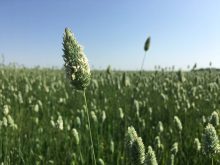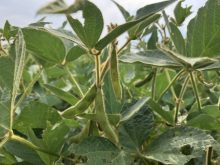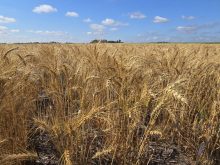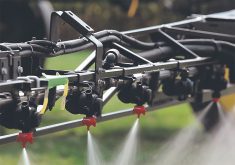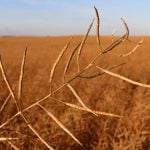It seems odd to be fretting about grasshoppers at a time of frozen nose drippings and frosted eyelashes, but insect specialists can’t keep their minds off the little critters lurking beneath the snow.
The three prairie provinces have released their 2004 grasshopper forecasts and despite the bitter cold there are numerous “hot spots” on each map.
Grasshopper levels are expected to be severe to very severe in the sandy soils of southwestern Manitoba, with a large circle around Brandon as the focal point of infestation.
In Saskatchewan, high populations have been found in a wide diagonal band stretching from Lloydminster, through Moose Jaw down to Estevan.
Read Also

University of Manitoba hires potato researcher
A new research chair position at the University of Manitoba will tackle sustainability in the potato industry.
Alberta has bothersome blotches along the Saskatchewan border, north of Edmonton and in the southwestern portion of the province.
The general consensus is farmers will be facing a similar onslaught of the crop and pasture eaters that they experienced in 2003.
“I’m expecting that the numbers will be very similar, but – and this is a really major but – a lot is going to depend on the weather conditions we get,” said Manitoba Agriculture entomologist John Gavloski.
Last month’s bone-chilling winter conditions won’t have much impact on the grasshopper eggs nestled two to four centimetres below the soil.
“They’ve got really good snow cover, so there should be very little winterkill,” said Gavloski.
What would take a huge bite out of populations is two weeks of wet weather in June when they’re hatching. Excessive moisture would cause the pests to succumb to disease and fungus.
For the past few years it has been the opposite scenario. Successive hot and dry summers led to a grasshopper explosion, which has seen the insect leap out of its traditional boundaries.
Saskatchewan Agriculture insect control specialist Scott Hartley said areas that had no problems before are now facing light to moderate infestations, forcing farmers in places like Carrot River and Hudson Bay to wage an unfamiliar war.
He has some advice for those growers and thousands of others facing the prospect of battling the winged foe.
Research has shown grasshoppers prefer to feed on spring wheat, rye, lentil pods and flax bolls rather than crops like oats, peas and canola. That information should be factored into producers’ cropping decisions.
Another good control technique is to eliminate green growth areas on farms. Weeds and volunteer crops provide food and shelter for the young hatchlings.
Getting rid of those problem areas this spring can help keep populations in check.
“You can essentially starve them out when they’re young because they don’t move that far,” said Hartley.
Regular scouting of field edges, fence lines, ditches, pastures and crops grown on stubble is another line of defence that should start in late May and run through mid-July, said Gavloski.
Depending on the level of infestation, farmers may consider a spreadable bait or spray for the insects when they’re in their second or third molt.
“You want to ideally hit them after most of the hatch is done, but before they’ve been able to move into a field,” he said.
Dan Johnson, professor of environmental science at the University of Lethbridge, said farmers often mistakenly worry about big grasshoppers they see in April and early May.
“If they see only a few they think, ‘We’re going to get off easier this year.’ Or if they see a lot they think, ‘Gee, we better spray early.’ But both of those conclusions are wrong,” said Johnson, who prepared Alberta’s forecast.
Those are adult hoppers that overwintered. It’s the ones that haven’t yet hatched that will soon be munching their crops.
“Any grasshopper that’s large before the end of May is not a pest,” he said.
Neither are the ones that make noises or have coloured wings.





